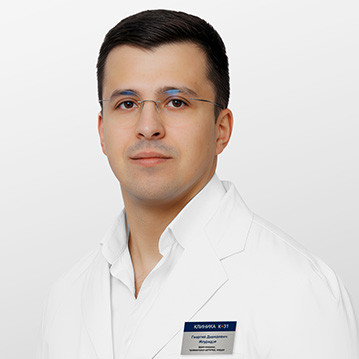Endometrioid ovarian cyst treatment
An endometrioid cyst, or endometrioma, is a cystic formation on the surface of the ovary filled with menstrual blood. It is most often found in women with endometriosis and can cause menstrual irregularities and infertility.
The K+31 Clinic diagnoses and treats endometrioid cysts using medications and modern minimally invasive technologies.

specialists

equipment

treatment
Causes and risk factors
Causes of endometrioid ovarian cyst formation
Endometriosis and endometriomas are interrelated pathologies, but are not always diagnosed simultaneously. Cysts typically form in patients with external genital endometriosis and endometritis (inflammation of the endometrium). In this case, lesions are also present on the fallopian tubes and in the abdominal cavity.
It is believed that portions of the uterine lining can migrate through the pelvic organs due to retrograde menstruation. This phenomenon occurs when blood containing fragments of the endometrium is partially refluxed back through the fallopian tubes, from where it ruptures into the ovaries or flows beyond the appendages into the abdominal cavity, settling on the mucous membranes.
Endometrial proliferation beyond the uterus can also occur due to injuries that occur during:
- Gynecological surgeries on the cervix
- Removal of fibroids or uterine tumors
- Medical abortion
- Childbirth
Hormonal imbalances and autoimmune pathologies can also be a cause.
Factors that trigger the formation of endometrioid ovarian cysts
The development of the disease can be influenced by hormonal imbalances caused by:
- Long-term use of an intrauterine device
- Inflammatory diseases of the reproductive organs (especially the uterus and ovaries)
- Thyroid, pituitary, and adrenal gland dysfunction
Obesity and liver disease can also trigger endometriosis, which leads to the formation of endometriomas.

Stages of endometrioid cyst development
As an endometriosis lesion transforms into a cyst, it goes through 4 stages:
- Small endometrial lesions, resembling several dots, appear on the outer surface of the ovary.
- On one ovary, the lesion hardens and grows. It does not exceed 5 cm in diameter. Endometriosis lesions also form in the peritoneum.
- Cystic lesions larger than 6 cm on one ovary may be present on the other, but smaller. Adhesions form on the appendages and intestines.
- The endometrioma is large and is diagnosed bilaterally. The endometriosis lesions have spread to all adjacent mucous membranes of the pelvic organs. Adhesions are severe.
The clinical picture and symptoms intensify with each stage.

Symptoms and Diagnosis
Early-stage endometriosis is painless and doesn't cause any symptoms. A woman may discover the presence of the pathological process accidentally, during a routine examination. Only the appearance of a cyst causes discomfort, indicating the progression of the disease.
Symptoms of an endometrioid ovarian cyst
As the pathology progresses and the cyst grows, symptoms intensify. In the final stage, the following are present:
- Lower abdominal pain, usually on one side, which intensifies during ovulation or sexual intercourse.
- Painful and heavy periods
- Development of anemia due to constant blood loss.
- Spotting before and after menstruation.
- Lack of ovulation.
- Infertility.
In stage 4 of the disease, when adhesions have already formed, attacks of severe abdominal pain often occur. Symptoms of intoxication may also occur, such as fever, weakness, nausea, and vomiting.
Many women discover they have an endometrioma while investigating causes of infertility. A secondary sign of cyst growth is the absence of eggs in the ovary.

Diagnosing an endometrioid cyst
A gynecologist may suspect a pathology based on the patient's complaints and after examining the patient on a gynecological examination chair and palpating the ovaries. However, the symptoms of endometrioma are similar to other diseases of the uterus and appendages. To make an accurate diagnosis and plan a surgical procedure, the doctor prescribes a comprehensive examination:
- Pelvic ultrasound (transvaginal and abdominal)
- Blood tests for hormones and inflammatory factors
- MRI (if the ultrasound is insufficiently informative)
- Diagnostic laparoscopy (examination of the ovaries from within the abdominal cavity)
Based on the examination results, a diagnosis is made, the stage of the pathology is determined, and any associated conditions are identified.
Treatment methods for endometrioid ovarian cysts
Conservative treatment (non-surgical)
In the early stages, when the endometriosis lesions are small and do not cause discomfort, the patient is recommended to see a gynecologist. Twice-yearly checkups can help detect the progression of the disease to endometriomas and prescribe treatment.
Drug therapy is used for cysts up to 5 cm in diameter. This includes:
- Anti-inflammatory medications for pain relief and inflammation
- Hormone therapy to normalize the menstrual cycle
If the patient is not planning a pregnancy, she is prescribed medications that "turn off" the ovaries, inducing a menopause-like condition. As a result, ovulation does not occur, the load on the ovaries decreases, and the cyst stops growing. If the woman plans to become pregnant, the doctor recommends surgical removal of the cyst.
Surgical treatment
Indicated when hormone therapy fails to produce lasting results. Surgery to remove an endometrioid ovarian cyst is most often performed laparoscopically. This allows for the removal of the pathology without an external abdominal incision and accelerates recovery.
There are several types of surgeries:
- Aspiration of contents
- Cyst removal
- Resection of the entire ovary
The simplest and least invasive method for reducing endometriomas is a biopsy with aspiration (suction) of fluid from the cyst. This is recommended when more radical surgical methods are contraindicated due to the risk of bleeding.
Endometrioid cyst removal is performed as part of a laparoscopic ovarian resection, but preserving the organ and restoring its function. Indicated for young women undergoing infertility treatment and planning a pregnancy.
Removal of the entire ovary, including the tumor, is performed in the presence of complications when the organ cannot be saved.
A biopsy is performed during diagnostic laparoscopy with a puncture in the navel area. During the examination, the doctor examines the organ from the inside, assesses the extent of the pathology, and takes tissue samples for analysis. Simultaneous aspiration of the cyst contents is also possible.
Laparoscopic surgery to remove a cyst or the entire ovary is performed under general anesthesia and includes the following steps:
- General anesthesia
- Using trocars, the doctor makes three punctures, approximately 5 mm in diameter, in the anterior abdominal wall. Tubes with medical equipment, optics, a camera, and lighting are installed.
- The surgeon locates the cyst and examines the internal cavity on an external screen. The desired area (the endometrioma or the entire ovary) is isolated and carefully excised with a miniature scalpel.
- The instruments are removed, and the puncture sites are sutured.
- The wounds are treated with an antiseptic and a sterile dressing is applied.
The entire surgery can take 1-2 hours. The patient remains in the hospital for observation for up to several days, depending on her condition.
What not to do with a stye
When a stye appears, it is prohibited to:
- Use alcohol, tinctures or other aggressive agents that can aggravate inflammation
- Remove the stye - can lead to the spread of infection or damage to the eyes
- Use cosmetic products and lenses

This award is given to clinics with the highest ratings according to user ratings, a large number of requests from this site, and in the absence of critical violations.

This award is given to clinics with the highest ratings according to user ratings. It means that the place is known, loved, and definitely worth visiting.

The ProDoctors portal collected 500 thousand reviews, compiled a rating of doctors based on them and awarded the best. We are proud that our doctors are among those awarded.
Make an appointment at a convenient time on the nearest date
Price
Other services






















































General information about endometrioid ovarian cysts
Normally, the endometrium is located within the uterine cavity and serves as the site where a fertilized egg is implanted. If fertilization does not occur, endometrial cells clump together and are shed during menstruation. In some cases, fragments of the endometrium can extend beyond the uterus and attach to the mucous membranes of other organs, forming endometriosis lesions. These lesions are most often found on the outer surface of the uterus and appendages, from where they can spread to the intestines and even lung tissue.
Focuses of endometriotic tissue are located outside the uterus; they bleed and increase in size during each menstrual period. If such a lesion is located on the ovary, it can eventually become encapsulated, collecting blood that has not been expelled. This is how endometriomas develop. Unlike regular cysts, their walls do not contain glands, and they always contain a brown blood clot.
44% of women diagnosed with endometriosis also have endometrioid ovarian cysts. These are usually bilateral, but the cyst on one side can be larger, reaching up to 12 cm in diameter.
The condition is hormone-dependent and is therefore only diagnosed in women of reproductive age, over 30 years of age. During menopause, the ovaries stop producing hormones, so these cysts can shrink and disappear on their own. However, without timely treatment, endometriomas disrupt a woman's reproductive function and, in advanced cases, cause chronic abdominal pain and heavy menstrual bleeding.